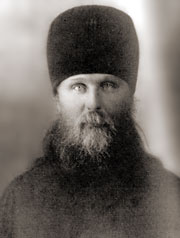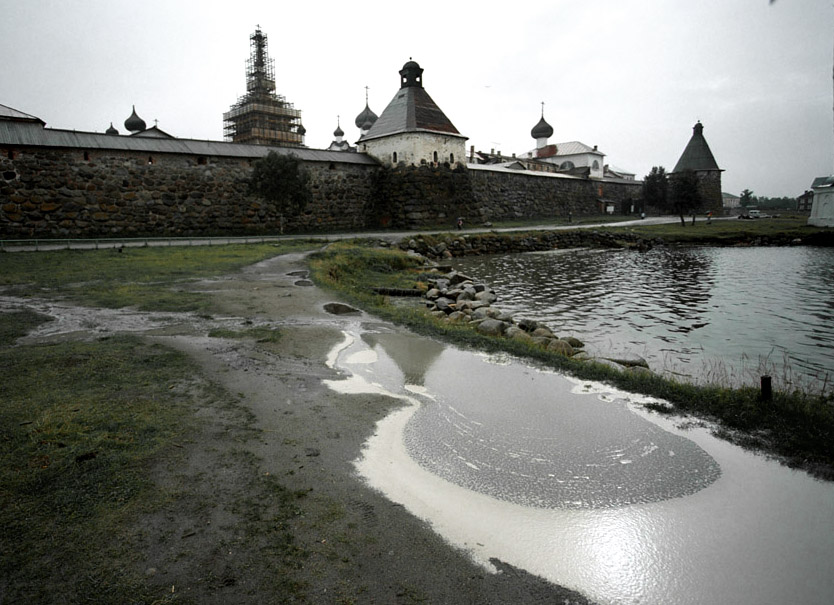 The Holy Martyr Archbishop Hilarion (Troitsky) is one of the most prominent figures in the history of the Russian Orthodox Church .
The Holy Martyr Archbishop Hilarion (Troitsky) is one of the most prominent figures in the history of the Russian Orthodox Church .
His ministry fell on that tragic period in the life of the Church when thousands of people were sent to labor camps and eliminated by Soviet authorities. The Church itself was also trying to survive the storm of Renovationist dissent.
Those hard times are now long gone and today we don’t have to stand up for our faith risking our lives. The Russian Orthodox Church is no longer persecuted. Yet the life and image of the Holy Martyr Hilarion is still very important to modern people. It is not solely an example of courage and unshakeable faith. Fr. Hilarion reminds us of what the Church is and what it should be for every person who considers him or herself a Christian. “I believe In One Holy Catholic and Apostolic Church ”. – this part of the Creed defines the main trend and spirit of his theological writings.
He was a joyous and light-hearted, spirited person. It’s not a coincidence that his name translates from Greek as ‘calm, tender, joyful’ (‘consoling’ according to one contemporary scholar). Tall and slender, with splendid blue eyes and a beautiful voice, always filled with inspiration and the joy of life, he resembled a “bogatyr”, one of those Russian mythical heroes with exceptional strength and sharp mind. His pure, noble soul shone through his outward beauty, and that was the source of his charm.
***********
The Holy Martyr Hilarion (Vladimir Troitsky in the world) was born on the 13th of September in 1886 in a small village called Lipitsy, in the family of a priest. Fr. Hilarion’s grandfather served in the Church of the Annunciation of The Virgin. The childhood of father Hilarion passed in the atmosphere of pure orthodox piety. From an early age, Vladimir (his name before taking on monastic vows) took part in church services – singing in the choir, reading the Hours and Psalms. His yearning for knowledge was also revealed very early. There’s a well-known story about how Vladimir once took his little brother by the hand and went to the nearest town – to learn. The younger brother got tired soon and started to cry, asking the elder to take him back home. “Alright then, you can stay unlearned all your life if you wish!” responded Vladimir .
In 1900 Vladimir Troitsky graduated from theological school in Tula and in 1906 – from the local theological seminary. Vladimir showed promise and was sent – at public expense – to continue his education in the Moscow Theological Academy . It was here that his theological views and scientific interests formed and coagulated.
Blessed Sergius of Radonezh, the founder of The Holy Trinity Lavra, said once that the animosity of this world can be overcome if we gaze at the Holy Trinity and these words echoed in the heart of the future archpriest. He later wrote: “There is no form of unity on earth with which one could compare the unity that is the Church. Such unity was found only in Heaven. In Heaven, the incomparable love of the Father, the Son and the Holy Spirit unites three Persons into one Being so that there are not three Beings, but One God living a triune life.” People who enter the Church and love Her become like the three Persons of the Holy Trinity, whose love unites them into one being. The Church is like one essence, colored by many people, tied together with love.
For his scientific work in 1913- “Essays on the history of Church doctrine”- Vladimir Troitsky was granted a Masters’ degree in Theology.
On the 28th of March in the Paraklyt Hermitage of the Lavra, he took on monastic vows with the name of Hilarion (in honor of st. Hilarion the New)
On the 30th of May 1913 father Hilarion was appointed inspector of the Moscow Theological Academy . He soon gained high authority as a teacher, theologian and famous preacher.
During the Sobor of 1917-1918, the issue of restoring the patriarchate had become particularly ripe in the Russian Church . Archimandrite Hilarion enthusiastically supported the restoration proposal.
Also at this very time, after the Bolsheviks gained power, the Russian Church began to be persecuted. It was already in March of 1919 that archimandrite Hilarion was arrested for the first time. His first imprisonment lasted a little over three months.
On the 25th of May 1920, archimandrite Hilarion was appointed bishop of Verey. His ministry as a bishop was a real cross-bearing and thorny path. Two years following ordination, he was exiled to Archangelsk, where he spent a year, isolated and cut off from church life. Having returned from exile, fr. Hilarion continued serving the church. He became a close associate of Patriarch Tikhon. The Patriarch soon ordained him archbishop of Verey.
Here are the memoirs of N.Okunev from his book “The diary of a Muscovite”
“During Holy week I really wished to go to church. Several times I went to the Sretensky monastery. It was father Hilarion who drew me to the monastery – not because of his services as a bishop, but by the way he took part in the services as a common monk. Once he appeared in the main church of the monastery without his panagia, wearing a simple monk’s chimer and kamilavka hat. He went to the left side of the choir and sang there in the company of four or five other monks. Then he stepped out, read the canon in a heartfelt manner and began to sing “Your palace, O Christ”. And what singing this was! He had the most pure and melodic tenor voice. He sang in a simple manner, by ear and not by sight-reading notes, but it was such a soulful and moving song…I can say I’ve never heard this beautiful hymn sang like that before”.
Soon, father Hilarion became a real threat to the Renovationists. They acted together with the communist authorities to destroy the Orthodox Church from within, by means of splitting it into different fractions. At the Renovationist Sobor in May 1923, they “deprived patriarch Tikhon of his Patriarch status and even his monkhood”. Many of the Moscow churches at the time were seized by the Renovationists, the followers of the so called “living church”. Being in a position of authority, father Hilarion took action against the schism. In July 1923 he served Vespers in the key church of Sretensky monastery, performing before it a rite of consecration and urging the clergy of the monastery to repent of their collaboration with the Renovationist trend and opposition to the Patriarch. Next day, the Patriarch himself served in the monastery. The services lasted all day and finished at six in the afternoon.
 Closely following this, father Hilarion was sent to the labor camp of Solovki. It was at the labor camp that the grandeur of his spirit was truly revealed. Archbishop Hilarion kept alive all the inner beauty of his soul that had developed through the years of monastic life. The people around him later recalled his absolute monastic piety, true simplicity, humility and childlike kindness. He was always joyous, and even if something troubled him, he tried to cover it by that strength and cheer of spirit. The influence of father Hilarion spread even to the camp thieves and criminals, whose trust it was very difficult to win. Father Hilarion amazed and inspired these people by his example.
Closely following this, father Hilarion was sent to the labor camp of Solovki. It was at the labor camp that the grandeur of his spirit was truly revealed. Archbishop Hilarion kept alive all the inner beauty of his soul that had developed through the years of monastic life. The people around him later recalled his absolute monastic piety, true simplicity, humility and childlike kindness. He was always joyous, and even if something troubled him, he tried to cover it by that strength and cheer of spirit. The influence of father Hilarion spread even to the camp thieves and criminals, whose trust it was very difficult to win. Father Hilarion amazed and inspired these people by his example.
In 1925 he was sent to the Yaroslavl prison where the communist agents tried to convince him to join the Gregorian dissent that also arose in the Russian Church . Father Hilarion remained adamant upon staying faithful to the pureness of Orthodoxy and was returned to Solovki. There, he continued to serve as peacemaker as he united exiled bishops who were in discord with each other because of the Renovationist schism influence. He diligently persuaded them to stay united and faithful to the Orthodox Church headed at that time by metropolitan Sergius (Starogorodskiy).
Only once while Archbishop Hilarion was on Solovki was her permitted to celebrate Easter Matins – in 1926. The following is an eyewitness description:
‘Silence, pitch dark all around…iridescent pillars sweep the sky – the northern lights… And finally the sacred songs are heard from the open doors of the church. Archbishop Hilarion’s cry thunders like a harsh command invested with heavenly power: ‘May God arise and His enemies scatter!’
Then, glittering with multicolored lights, the unprecedented procession of the cross started out from the church gate. Surrounded by lamps and torches, the seventeen bishops in their ancient vestments were followed by more than two hundred priests and as many monks, and behind them walked an endless wave of those whose tormented hearts thirsted for one thing – the Light of Resurrection.”
Out of the church doors sailed the sacred banners sewn by master craftsmen of Great Novgorod, followed by lanterns donated to the monastery by Venetian doges. Sacred vestments embroidered by the Moscow Grand Duchesses shimmered on the clergy.
‘Christ is Risen!’ proclaimed Archbishop Hilarion.
‘He is Risen indeed!’ echoed the reply of a thousand voices…’
In December 1929 archbishop Hilarion was sent to a settlement in Asia . He went from one prison to another and arrived in Leningrad dressed in rags and gravely ill. He died of typhus on a prison bed soon after. Amazingly, metropolitan Seraphim (Chichagov), who later became a Holy martyr as well, was granted permission to take the body for church burial. The white archbishop garments for the burial were brought to the hospital. Archbishop Hilarion was robed and taken to the church of the Novodevichy monastery, where he was buried.
On the May 10th1999, the Holy Martyr Hilarion, Archbishop of Verey, was finally sanctified by the Russian Orthodox Church and little before that his relics were brought to the cathedral of the Sretensky monastery in Moscow where they are to this day – imperishable and testifying to fr. Hilarion’s pure life.













